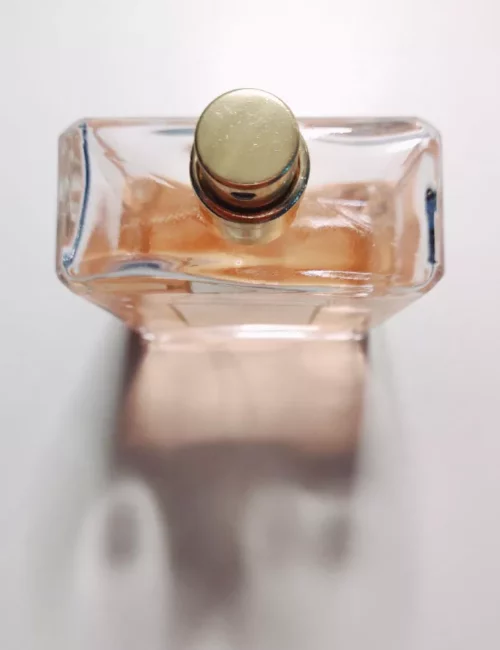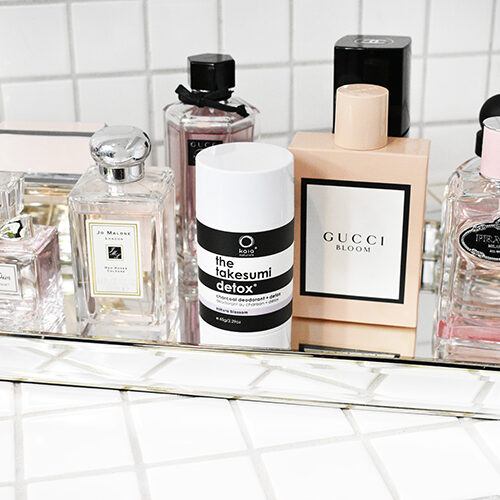
WHY THIS DEODORANT INGREDIENT COULD BE GIVING YOU AN ARMPIT IRRITATION
While there are many reasons why you may experience armpit irritation, one of the leading causes is fragrance. Given that underarms are one of the most sensitive parts of your body, it’s important to be cautious of using highly scented products in these areas. However, if you’re like me and you love the luxurious feeling of wearing fragrance, there is still a way that you can enjoy it without risking a nasty rash or armpit irritation.
THE TROUBLE WITH FRAGRANCES IN DEODORANT
I find fragrance to be one of life’s delightful little luxuries, but it can be difficult to enjoy the positive effects of fragrance when many manufactures use our love of fragrance as a reason to load up products like natural deodorants and antiperspirants with high levels of fragrance.
Dermatologists dislike fragrance as it is often the cause of allergic contact dermatitis (ACD). “ACD is a specific type of contact dermatitis that develops after more than one skin contact with an allergenic chemical, ACD to fragrances is alleged to be a common cause of contact allergy to cosmetic products.”

Most people do not understand that their armpits are incredibly sensitive compared to other areas of the body because it is a dark, warm, moist environment. So as much as we may love fragrance, we need to be aware that fragrance can wreak havoc under there.
Fragrance formulations are complicated, but you don’t need to stop using a deodorant with fragrance, you just need a way of knowing if there is too much fragrance in it. Knowing about the different types of fragrance will help you be aware of what’s in your deodorant even if the fragrance ingredients are not listed. This way you can make a well-informed decision when buying deodorant and can decrease your chances of getting armpit irritation from fragrance.
THE DIFFERENT TYPES OF FRAGRANCE

FRAGRANCE-FREE
Fragrance formulas are extremely complex and can consist of hundreds of ingredients, so even if a product is labelled as fragrance-free you can still be exposed to fragrance ingredients. Oftentimes these ingredients are use as preservatives or used as an active in the formula.
Fragrance-free products cannot contain ingredients that are normally used to transmit a scent; however, a fragrance-free product may contain essential oils like tea tree and lavender. These oils often contain medicinal properties which is why they could be included in the formula. They most likely will not be listed as fragrance however, they can cause a reaction if they are used at high levels.
SYNTHETIC FRAGRANCES
Research from the National Institute of Health reports that, “fragrance is primarily made from synthetic compounds. Approximately 3000 compounds are recorded that can go into a fragrance blend.”
Not only are synthetic fragrances less expensive than natural fragrances, but they are also easier to manufacture. Synthetic fragrances don’t rely on nature which makes them more reproducible. However, by law in most countries manufactures are not required to disclose the compounds in the mixture which makes it difficult for the consumer to know what they’re doing.
NATURAL FRAGRANCES
Many manufactures are a part of The International Fragrance Association (IFRA). The IFRA has an established Code of Practice and safety standards used around the world to keep consumers and the environment safe from the effects of fragrance. According to the IFRA, “there is no official term for ‘natural in fragrance industry.'” The IFRA defines natural, “as, means existing in, or produced by nature.”
The IFRA has a standard by which manufactures must follow in order to call their fragrances natural. The standard requires that aromatics are made physically extracting the volatile fractions from plants WITHOUT chemically altering them. Natural aromatic raw materials must be physically obtained from plants using distillation, expression and extraction.
ESSENTIAL OILS
Essential oils are extracted from plants by cold pressing or distillation. The oil emits the plants scent and manufactures utilize the oil to then create a fragrance or use them as actives in a formulation. They are used as actives because of their medicinal properties but they still can be a very potent allergen.
THE FRAGRANCE RULE OF THUMB
I know that using fragrance in the morning is satisfying especially when used in products that help combat odor. As a product developer there is actually a rule of thumb when developing deodorants; never ever exceed 3% fragrance, period. Since I develop natural products, I only use essential oils or natural scents, but they can still be allergens. My rule at kaia is only to use 0.05% fragrance because if 3% is the top limit I know that can still cause armpit irritation. This is why my deodorants are lightly scented, only 0.05% of the formula is fragrance, making them suitable for sensitive skin.

DO THE SNIFF TEST TO REDUCE CHANCES OF ARMPIT IRRITATION
Reading fragrance labels is complicated so here is a simple yet effective method to finding out how much fragrance is in your deodorant. If you can smell the fragrance before you even open the container, chances are it has high levels of fragrance. If you’re immediately hit with an overwhelming scent, then that’s a sign that the fragrance levels are well beyond one percent.
Remember, everything is okay in moderation and life is about balance. Just like having too many glasses of wine is probably not a great health choice, using products with high levels of fragrance also has its consequences.
If you sniff it and there is a very mild scent, then you should be okay to use it. Choose lightly scented deodorants with natural or essential oil blends. This way you know what the blend is made up of. With the sniff test you’ll have more of an idea of how much fragrance is in there. You can still enjoy fragrance and avoid armpit irritation if there are low levels of fragrance in your deodorant.
BE CAREFUL OF PAINFUL ARMPIT IRRITATION

Don’t get me wrong, I love fragrance as I believe it is truly an integral part of my life. However, I want natural fragrance blends, and only at low levels. This is especially important with deodorant, as it’s used in a sensitive area. Armpit irritation is often the results of over-doing the fragrance in a deodorant, so be careful!
I paid very close attention to the levels of natural fragrance used in the takesumi detox® and the takesumi bright deodorants. Although our deodorant scents are 100% natural and derived from essential oils, they are integrated at very low levels in order to protect our consumers from armpit irrtation.

All content found on this website is created for informational purposes only. The content is not intended to be a substitute for professional medical advice, diagnosis, or treatment. Always seek the advice of your physician or other qualified health provider with any questions you may have regarding a medical condition. Never disregard professional medical advice or delay in seeking it because of something you have read on this Website.




